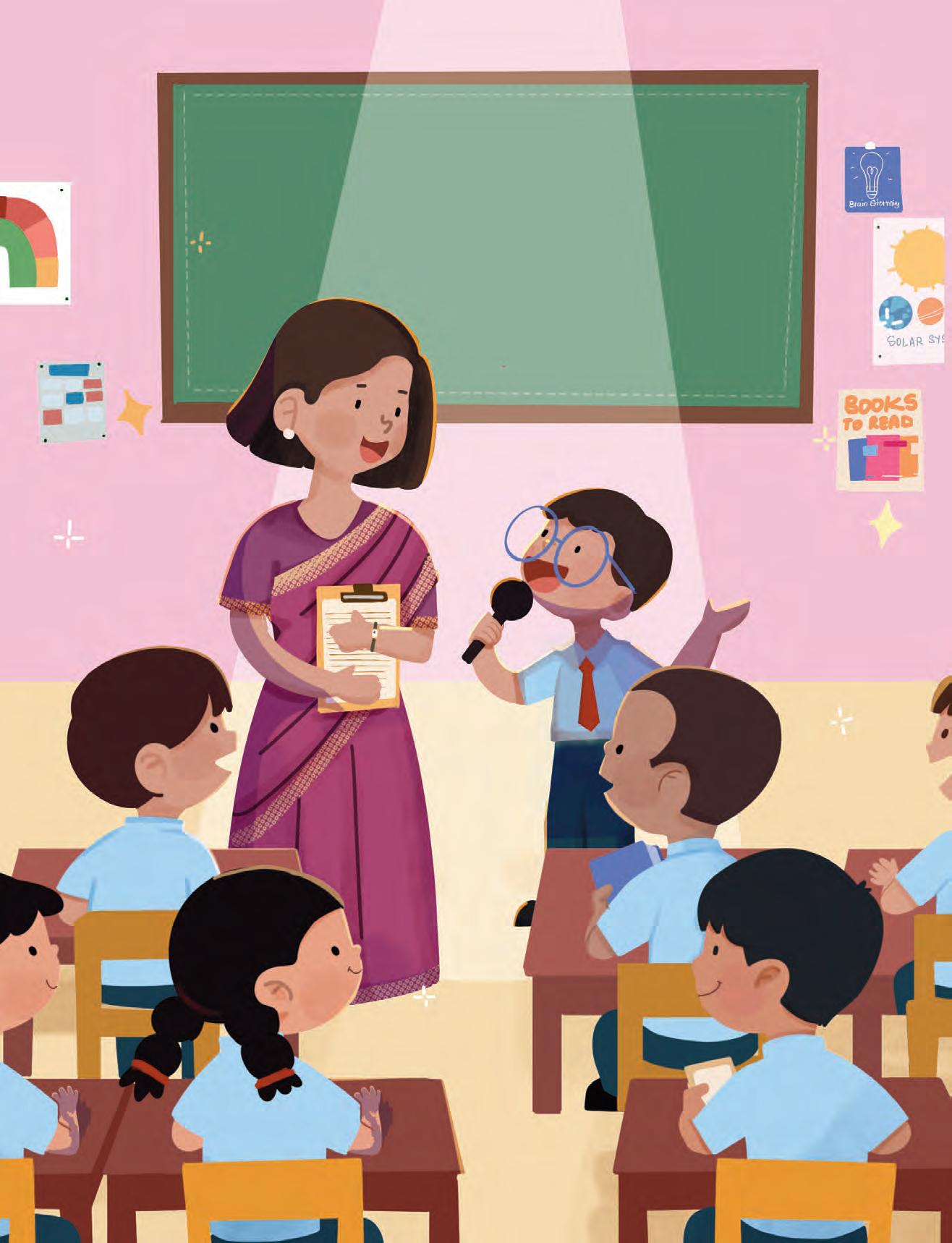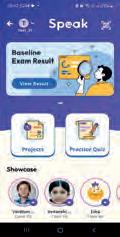

Achieve Fluency in Verbal Communication

Get access to animated learning videos, interactive quizzes, projects and more — all on the Uolo Learn app!




Get access to animated learning videos, interactive quizzes, projects and more — all on the Uolo Learn app!
Achieve Fluency in Verbal Communication

Academic Authors: Kashika Parnami, Sneha Sharma, Simran Singh, Arpit Agarwal, Laraine O’Connell
Creative Directors: Bhavna Tripathi, Mangal Singh Rana, Satish
Book Production: Rakesh Kumar Singh, Tauheed Danish
Project Lead: Chandani Goyal
VP, Learning: Abhishek Bhatnagar
All products and brand names used in this book are trademarks, registered trademarks or trade names of their respective owners.
© Uolo EdTech Private Limited
First edition 2026
This book is sold subject to the condition that it shall not by way of trade or otherwise, be lent, resold, hired out, or otherwise circulated without the publisher’s prior written consent in any form of binding or cover other than that in which it is published and without a similar condition including this condition being imposed on the subsequent purchaser and without limiting the rights under copyright reserved above, no part of this publication may be reproduced, stored in or introduced into a retrieval system, or transmitted in any form or by any means, electronic, mechanical, photocopying, recording or otherwise, without the prior written permission of both the copyright owner and the above-mentioned publisher of this book.
Book Title: Speak 2.0 4
ISBN: 978-93-89057-32-4
Published by Uolo EdTech Private Limited
Corporate Office Address: 91Springboard, 3rd Floor
145, Sector 44, Gurugram, Haryana 122003
CIN: U74999DL2017PTC322986
Printed by: Kumar Offset Printer
Illustrations and images: www.shutterstock.com, www.stock.adobe.com and www.freepik.com
All suggested use of the internet should be under adult supervision.
In the age of globalisation and unprecedented technological advancement, English stands as a universally comprehensible medium of communication. It has evolved into one of the essential tools that learners require to thrive in today’s world and secure their future. Studies from across the globe show that English communication skills significantly impact on career prospects and lifelong learning.
Functional and fluent communication skills in English, encompassing the crucial facets of LSRW (Listening, Speaking, Reading and Writing), are pivotal to children’s knowledge acquisition, intellectual, socio-emotional development and lifelong learning.
In particular, robust listening and speaking skills not only form the bedrock of the language learning process but also pave the way for enhanced reading and writing capabilities. Yet, the majority of educational efforts prioritise teaching reading and writing from the very outset, sometimes neglecting listening and speaking skills. These foundational skills are often overlooked in educational institutions due to high pupil-teacher ratios, lack of opportunities to express themselves in English, and most significantly, a lack of structured and dedicated class time for honing these skills.
It is within this context that Uolo Speak 2.0 has been introduced as a groundbreaking English program tailored for learners in pre-primary to grade 8, with a special emphasis on English listening and speaking. In alignment with the National Education Policy (NEP) of 2020 and the learning outcomes set forth by the National Council of Educational Research and Training (NCERT), the books comprise 12 chapters on essential functional skills, with the last three advantage chapters to be used at the teacher’s discretion, depending on learners’ readiness.
The Speak 2.0 book serves as the classroom-based avenue for developing functional speaking skills. The book contains teacher-led English speaking and listening activities that adhere to the highly recommended and research-based teaching-learning method known as the Gradual Release of Responsibility (GRR). This approach systematically guides learners to master the targeted competencies. Through these activities, learners engage in high-quality, age-appropriate and experiential tasks that foster confidence and fluency in English. The accompanying Teacher Manual provides in-depth implementation plans for these activities.
AI lies at the heart of Speak 2.0, powering digital experiences that make learning English speaking dynamic and personalised. The package comes with digital content, provided free of cost, to ensure a seamless and holistic learning experience for children.
The mobile interface ensures consistent practice of functional English skills, while learners participate in speaking tasks enriched with AI-based evaluation and real-time feedback. Acting as a smart companion, AI guides pronunciation, sharpens usage and enhances accuracy, encouraging learners to practise with confidence. With this seamless blend of AI-driven practice and feedback, learners steadily build fluency and gain the confidence to express themselves effectively in everyday communication.
Uolo Speak 2.0 offers a potent, captivating and unique learning experience for learners. It embodies a pragmatic, results-oriented approach to cultivating indispensable functional English skills required for the 21st century. We extend our warmest wishes to all educators, parents and learners as they embark on this exciting journey with Uolo Speak 2.0, filled with fun and joyful experiences.

Dr Laraine O'Connell
I am a veteran English teacher and lecturer, with a great love for English and for teaching. I have taught English and trained teachers over many years. I live in South Africa and it is a wonderful experience working with a company promoting the learning of English in India.
Welcome to the Speak 2.0 journey!
The program is a thoughtfully crafted activities-based learning experience that build students’ speaking skills in English. The program, with dedicated time and space within the classroom, becomes a platform to practice speaking and listening skills in everyday scenarios. These scenarios are created by way of teacher-led activities, which cater to specific competencies in English.
Course Book
Speak on the Spot Activities
Prepared-speaking Activities
Teacher Manual
Student and Teacher Apps
Talking Books
Listening and Speaking Projects
Interactive Practice Quizzes

The classroom program is augmented by the digital world, which is presented to the students through the UOLO App. The app includes projects that are closely associated with the activities in the coursebook. The projects allow a fear-free practice time to children at home and are AI evaluated. The app also includes quizzes in listening, speaking, reading and writing that can be consumed at home.

The National Education Policy (NEP) 2020, introduced by the Government of India, represents a transformative shift in the country’s education system. It aims to create a more holistic, dynamic and multidisciplinary approach to education. NEP 2020 focusses on fostering conceptual understanding, skills, values and competencies that align with the demands of the 21st-century, while also preserving India’s rich cultural heritage. UOLO is fully committed to actualising the vision of NEP 2020 by meticulously adhering to its outlined recommendations.



1. Comprehension and understanding
2. 21st century skills, values and dispositions
CompetencyBased Education
3. Application in real life




4. Holistic and integrated learning
5. Enjoyable and engaging
6. Collaborative and exploratory activities
NEP Pages 12, 17, 22
Teaching and Learning Pedagogy
7. Technology-based solutions

NEP Pages 3, 11, 12, 27
8. Assessment of core concepts and application skills Assessments
NEP Pages 12, 18, 22
Exposure to rich literature, as stories and poems, that demonstrate essential speaking behaviours and competencies.
1 2 3 4 5
Build mastery in new words usage, and expression, while also strengthening phonics skills to lay a strong foundation for reading and pronunciation.
1 2 7
Enhanced listening comprehension and elevated English learning experience through animations that bring each text to life.
1 5 7

Digital projects and supportive platforms that present English speaking opportunities in a fear-free environment.
2 3 4 5 7 8
Classroom activities and presentations that help build confident expression and language usages in everyday scenarios.
2 3 4 5 6 8
1 Comprehension and understanding
2 21st-century skills, values and dispositions
3 Application in real life
4 Holistic and integrated learning
5 Enjoyable and engaging
6 Collaborative and exploratory activities
7 Technology-based solutions
8 Assessment of core concepts and application skills

‘In the 21st century, language teaching must go beyond traditional approaches and must aim to enable students to use language skills in real-life contexts for a wide variety of purposes.’ (NEP, 2020)
According to Vygotsky and Krashen’s theory of second language teaching, language acquisition happens best when learners are engaged in purposeful and meaningful tasks in an anxiety-free, non-judgmental, communication-oriented, input-rich, supportive and stress-free environment, along with a lot of scaffolding practices. This approach to secondlanguage teaching is also highlighted by the NIPUN Bharat Mission document and NEP 2020.
In this context, the Speak 2.0 series, along with the learning activities designed in it, can play a crucial role in creating an input-rich environment, employing diverse avenues for speaking practice in a fear-free and non-judgemental setting, coupled with real-time feedback.
The book has been developed based on the ‘Gradual Release of Responsibility’ (GRR) model— a teaching-and-learning model that has been widely recommended by the NEP 2020 and the NCF 2022-23. The GRR has been promoted by educational researchers and practitioners all over the world for its effectiveness in promoting student engagement and deep understanding of content and skills.
The GRR model includes three steps, each one consecutively shifting the ‘responsibility’ from teachers to learners so that learners become independent users of the language.
I do: The teacher first provides explicit instructions and modelling that initiate the learning process.
We Do: As learners begin to grasp the content and skills, the teacher also begins to shift the responsibility to them, facilitating a guided practice where the teacher and the learners participate collaboratively.
You Do: Finally, the learners take full ownership of their learning through independent practice and the application of the skills learnt in the program.
Based on this approach, there are three core instructional models on which the activities work (please refer to lesson plans in the Teachers' Manual for greater clarity). These are:
I do We do You do Listen Echo Express and Repeat (E&R)
Fully guided; Modelled speaking by the teacher
Collaborative; Shared speaking between the learners and the teacher Independent practice and application by the learners
To sum it up, this has been created to do away with the fear of speaking in English among learners and allowing them to express themselves confidently in English in real-life situations.
The National Curriculum Framework for Foundational Stage (NCF) , released in 2023, is developed based on the vision of the National Education Policy (NEP) 2020, and to enable its implementation. The NCF provides guidelines for designing school syllabi and textbooks in India. It aims to improve the quality of education by making it more relevant, engaging, inclusive, and learner-centric. To achieve this, the NCF has articulated precise Learning Standards through well-defined Curricular Goals and Competency statements. These statements serve to harmonise the syllabus, content, pedagogical practices, and assessment culture, ensuring a cohesive and comprehensive educational experience. Curricular Goals: Curricular Goals are statements that give direction to curriculum development and implementation. They are derived from Aims and are specific to a Stage in Education.
Competencies: Competencies are learning achievements that are observable and can be assessed systematically. These Competencies are derived from the Curricular Goals and are expected to be attained by the end of a Stage.












C-1.1 Converses fluently and meaningfully in different contexts












C-1.2 Describes an outline of the material that has been read out and answers questions related to it












C-1.3 Summarises core ideas from the material that was read out














C-1.4 Demonstrates the ability to speak their reasoning coherently















C-1.5 Makes oral presentations (class debates, short welcome notes, anchoring of small events, short speech, and so on)
C-4.1 Uses knowledge of homophones, word roots, affixes, suffixes, synonyms, and antonyms
C-4.2 Discusses meanings of words and develops vocabulary by listening and reading a variety of texts or other content areas
CG-1
Students develop oral language skills using complex sentence structures to understand and communicate abstract ideas.
CG-4
Students acquire a more comprehensive range of words in various contexts (of home and school experience) and through different sources.
1
Talking About Self and Others
2 Sharing Feelings
3 Describing an Experience
4 Informal Conversations
5 Giving Compliments
6
Step-by-Step Instructions
7
Talking About Imagination
8 Conversations in Daily Life
Retell important details about a person
Share important and interesting things about oneself, in some detail
Share some details about events
Share personal feelings associated with the events
Answer simple questions about one’s experience
Describe an experience, in brief
Engage in simple conversations on everyday topics
Answer simple questions during informal conversations
Give simple compliments using polite and kind words
Use polite expressions to appreciate someone’s work or effort
Follow instructions involving multiple steps
Give clear instructions in order to get something done
Talk about what could happen in imaginary situations using simple sentences
Share your imagination and creative thoughts in brief
Ask questions politely during a conversation
Share responses and feelings during a conversation 9 Making Announcements
Identify key details from an announcement
Make a short announcement
Talk about future plans and events
Making Predictions
Make predictions about future events 11 Solving a Problem
Describe a small problem clearly using complete sentences
Suggest a helpful idea with a proper reason.
Present a short speech on a topic in a formal manner
Deliver a Speech
Present the speech with appropriate body language, fluency and confidence

Talking About Self and Others
Talking About Self and Others Chapter 1

Talking Book: Animated video of the text
Keywords: Keywords from the text with meaning and pronunciation

Talk Toolkit
The most interesting thing about him/her is...
Talk Toolkit: learners with essential vocabulary and language structures for the target speaking competency
He/She is really good at...
I admire him/her because...
E-Speak 1: A series of three guided speaking projects on the mobile app
I always try to…
One thing I often forget…
One thing that makes me special is...
Gaming Zone 1 and 2: Fun activities aligned with the big skill
I want to learn how to…









Speak on the Spot: Impromptu speaking activity to be done in the classroom
E-Speak 2: A short, open-ended, assessment-type project on the mobile app
Speaking prompts with no expectation of writing


Practise: Guidance on how to practise at home

Tips: Helpful points for better speaking







Reflection Journal: A template for reflecting on the achievement of the targeted outcome


My best friend is a kind, brave and intelligent girl.

The most interesting thing about him/her is...

The most interesting thing about her is that she can solve any puzzle in just a few minutes./ The most interesting thing about him is that he builds small robots at home.
He/She is really good at... She is really good at skipping rope./ He is really good at playing the guitar.
I admire him/her because... I admire her because she is always kind./ I admire him because he never gives up.
I always try to… I always try to be on time./ I always try to help my friends.
One thing I often forget…
One thing that makes me special is...
One thing I often forget is to bring my diary./ One thing I often forget is to wear my ID card.
One thing that makes me special is my big imagination./ One thing that makes me special is that I can make my friends laugh.
I want to learn how to… I want to learn how to play the piano./ I want to learn how to swim.







In this chapter, I learnt to . New words I learnt: Think about someone you know who inspires you. It could be a friend, classmate or a family member. What do they do that makes them special? Write 4–5 sentences.



I feel wonderful.
How do you feel today?


















In this chapter, I learnt to . New words I learnt: You’re on stage for a fancy dress competition. The curtain opens and everyone is looking at you! How do you feel? Write in 4–5 sentences.
How confident do I feel to talk about an event and my feelings?
I need help.
I think I can do it. 3 I feel confident.







It was wonderful. I enjoyed riding my new bicycle.
How was your experience?










In this chapter, I learnt to . New words I learnt:
Describe your experience of learning to ride a bicycle in 4–5 lines.
How well can I describe my experiences and feelings? 1 I need help.
















You are so good at solving puzzles. Thank you!













In this chapter, I learnt to . New words I learnt: Write a short note in 4–5 lines to your parents complimenting them and expressing your appreciation of their good qualities and unconditional love.
How confident do I feel in giving simple compliments using polite words? 1 I need help. 2 I think I can do it. 3 I feel confident.






What should I do after that?
Next, mix it for some time.














In this chapter, I learnt . New words I learnt: Garima needs help organising her school bag. Write the steps in 4–5 sentences to help her.
How confident do I feel in giving step-by-step instructions?






Imagine if the sun and the moon could dance.
What if they performed in a band?
















How would you like your haircut today?

I would like to have a trim.
Thank you, Uncle!


















In this chapter, I learnt to . New words I learnt:
You came home from school. Your mother asked you about your day. Write a short conversation between you and your mother in 3–4 lines.
How confident do I feel conversing in English in daily life? 1 I need help. 2 I think I can do it. 3 I feel confident.






May I have your attention?












It might start raining any minute.
Perhaps it will rain heavily.









The city is getting dirtier day by day.






You spilt juice on the desk.

Ask the friend how they are feeling.
Your friend looks sad.
Ask a friend to give you one.
You broke your pencil. Ask the teacher politely for help.
You don’t understand the homework.
Say sorry and clean it up.










Today, I will deliver a speech on saving our Mother Earth.

Her speech is very powerful.











This SPEAK 2.0 book aims to systematically build English language skills in learners and enable them to verbally express themselves in real-world situations. Each chapter focusses on building specific English language competencies and weaves together activities that are research-based, age-appropriate, contextual, experiential and joyful. The activities adhere to the highly recommended and research-based teaching-learning method known as the Gradual Release of Responsibility (GRR), which has been endorsed by the NEP 2020 and the NCF 2022–23. Through the series, learners receive dedicated time and space within the classroom to express themselves in English which helps them in becoming confident speakers of the language.
• Activity-Based Learning: The book offers joyful experiential activities that build English communication competencies.
• Texts per the NEP 2020 Themes: The book has exciting and stimulating texts that pave the way for English communication activities.
• Tech Integration: The book works in sync with our digital component, where various other activities and projects are undertaken. Learner outputs are evaluated through an AI-based speech recognition engine.
• Teachers’ Manual: The book is complemented by the Teachers’ Manual that enables teachers to conduct each session effectively.
Uolo partners with K-12 schools to provide technology-enabled learning programs. We believe that pedagogy and technology must come together to deliver scalable learning experiences that generate measurable outcomes. Uolo is trusted by over 15,000+ schools across India, Southeast Asia and the Middle East.
ISBN 978-93-89057-32-4
